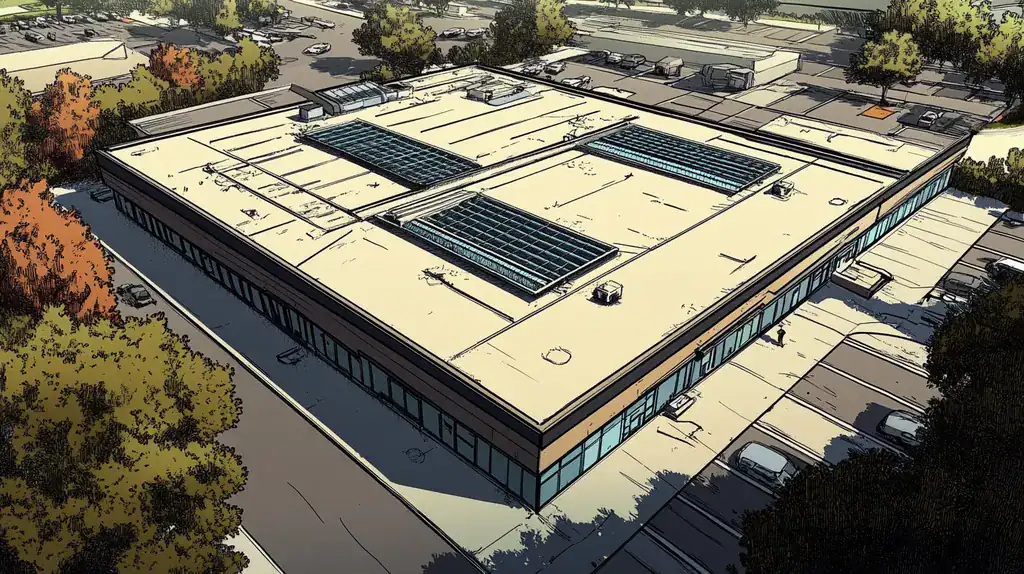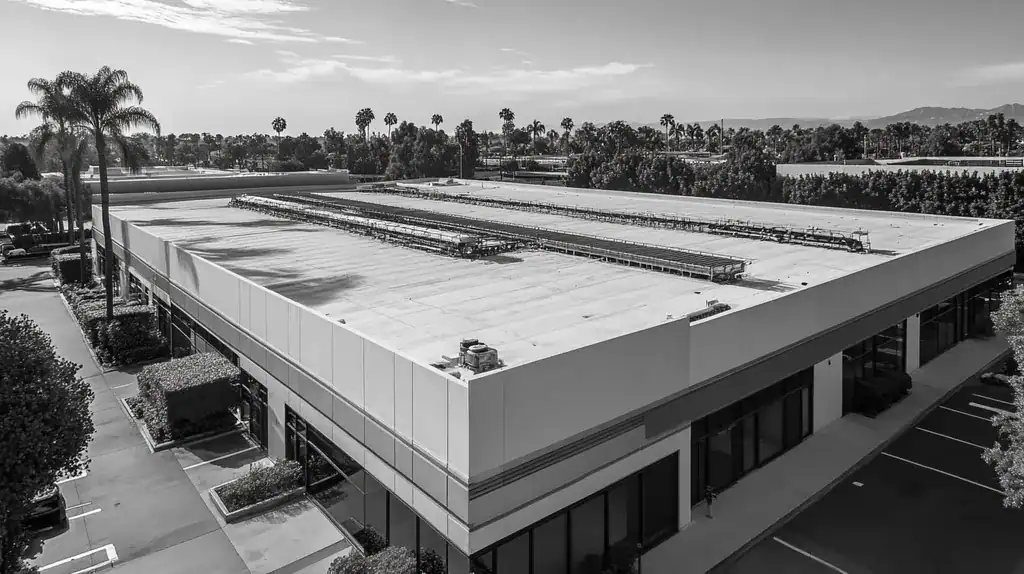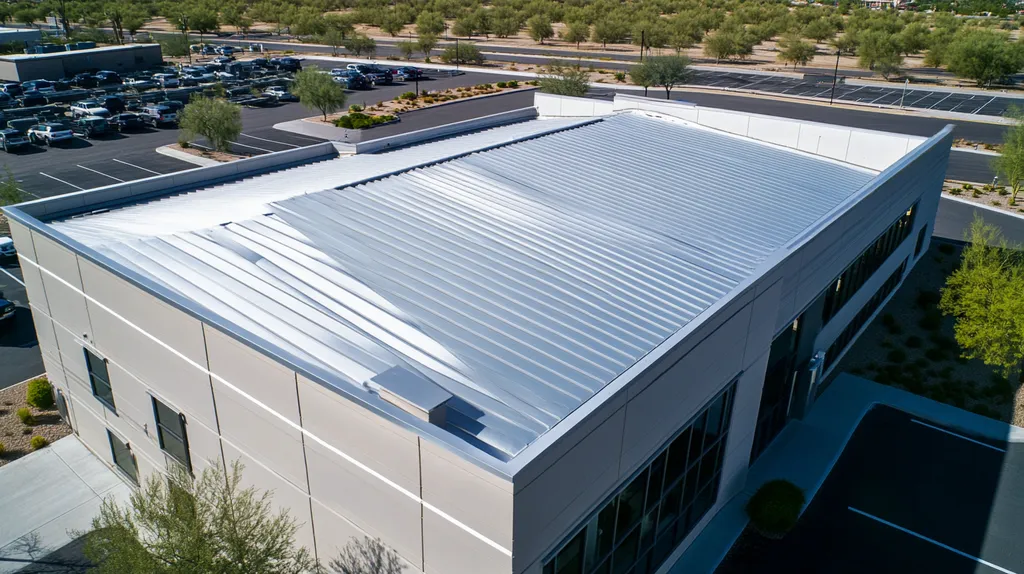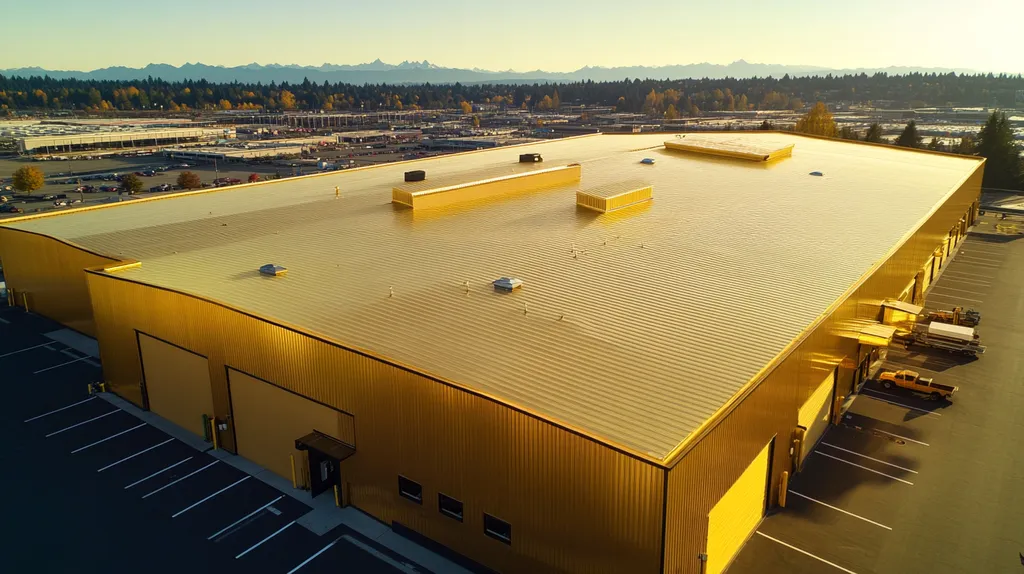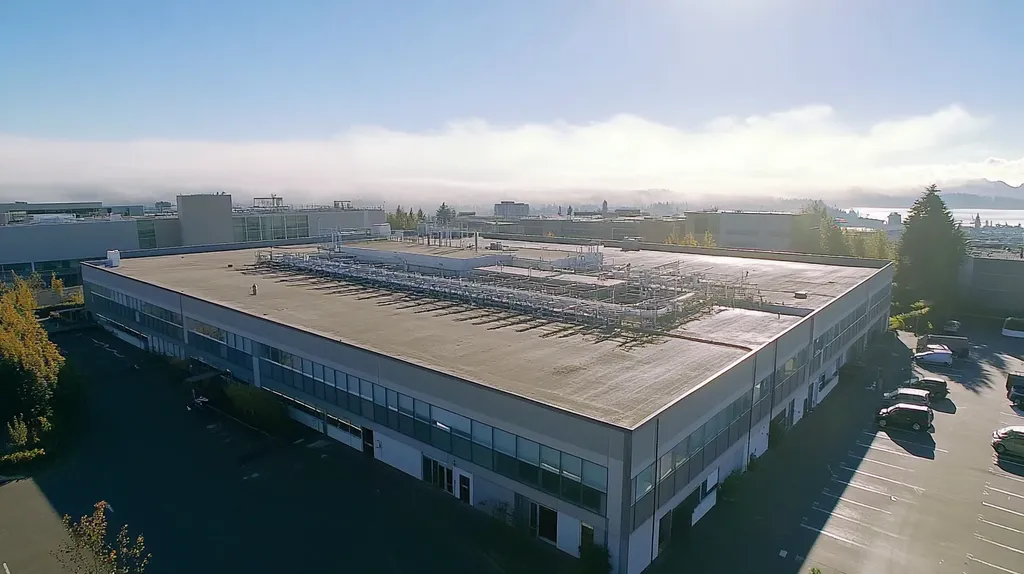Commercial property owners lose millions each year by mismanaging their roofing budgets, with 85% of replacements occurring years earlier than necessary due to preventable mistakes.
From overlooking critical maintenance to misunderstanding material costs, common budgeting errors create a cascade of expensive consequences that threaten both building integrity and bottom-line results.
This comprehensive guide separates roofing fact from fiction, providing property owners with evidence-based strategies to maximize their roofing investment while avoiding costly pitfalls that plague the industry.
SECTION 1: COMMON MISCONCEPTIONS
Commercial roofing decisions can make or break a property’s financial performance, yet many owners operate under misconceptions that drain their budgets. Every year, businesses waste millions on preventable roof damage, inefficient materials, and missed energy-saving opportunities. Three critical misunderstandings consistently surface: the true value of preventive inspections, the real cost implications of material choices, and the substantial impact of energy efficiency on bottom-line results.
Overlooking Regular Inspections
Most commercial roof failures start with minor issues that go undetected for months or years. While 85% of commercial roofs are only inspected after problems become visible, this reactive approach typically costs 4-5 times more than preventive maintenance.
Small leaks can saturate insulation and corrode structural components long before interior water damage appears. A professional inspection can detect these hidden issues through infrared scanning and moisture testing, preventing catastrophic failures.
Twice-yearly professional inspections typically cost less than 1% of roof replacement value. This minimal investment helps property owners avoid emergency repairs that can cost 10-20 times more than planned maintenance.
Regular inspections also provide crucial documentation for warranty claims and help facility managers develop accurate long-term budget forecasts.
Misjudging Roof Material Costs
The true cost of a commercial roof extends far beyond the initial price tag. While basic materials might save 10-15% upfront, they often require replacement in half the time of premium options.
Quality materials typically offer superior resistance to UV damage, temperature fluctuations, and severe weather. These performance advantages translate directly into reduced maintenance costs and extended service life.
Premium materials often come with longer warranties and better manufacturer support. This additional protection can save thousands in repair costs over the roof’s lifespan.
Modern high-performance materials also integrate seamlessly with smart monitoring systems, allowing for proactive maintenance that extends roof life by 25% or more.
Ignoring Energy Efficiency Benefits
Cool roofing technologies can reduce peak cooling demand by 10-15% in single-story buildings. Despite this potential, many owners focus solely on waterproofing when selecting roofing systems.
White or reflective roofing materials can lower roof surface temperatures by up to 50°F compared to traditional dark surfaces. This temperature reduction directly impacts building cooling costs and HVAC system longevity.
Enhanced insulation and modern roofing assemblies can reduce total building energy consumption by 15-30%. These savings compound annually, often paying for premium materials within 3-5 years.
Many utility companies and government agencies offer substantial rebates for energy-efficient roofing upgrades. These incentives can offset 20-30% of project costs, yet often go unclaimed due to lack of awareness.
SECTION 2: PRACTICAL IMPLICATIONS
The financial stakes of commercial roofing decisions extend far beyond immediate repair costs. Studies show that properly maintained roofs can last 21-30 years, while neglected systems often fail in less than 15 years. This dramatic lifespan reduction translates into millions in unnecessary replacement costs across commercial properties. Understanding these implications helps owners make informed decisions about maintenance, scheduling, and occupant impact.
Financial Impact of Neglect
The true cost of roofing negligence often lurks beneath the surface. What begins as a minor leak can escalate into structural damage, mold remediation, and inventory losses that dwarf the initial repair costs.
Emergency repairs typically cost 3-4 times more than scheduled maintenance. These urgent interventions often require overtime labor, rush material orders, and temporary solutions that need additional work later.
Insurance carriers increasingly scrutinize roof maintenance records when processing claims. Properties with documented neglect often face higher deductibles, reduced coverage, or even policy cancellation.
The ripple effects extend to operational costs, with compromised roofs driving up heating and cooling expenses by 20-35% due to damaged insulation and air infiltration.
Importance of Maintenance Scheduling
Strategic maintenance scheduling transforms roofing from a reactive expense into a manageable investment. Well-planned programs typically include spring and fall inspections, with additional checks after severe weather events.
Digital maintenance tracking systems help facility managers anticipate needs and bundle repairs efficiently. This proactive approach reduces emergency calls by up to 70% while extending roof lifespan.
Scheduled maintenance allows businesses to perform repairs during optimal weather conditions and low-activity periods. This timing minimizes disruptions and ensures quality installation.
Regular maintenance also creates detailed documentation of roof condition and repair history. This record-keeping proves invaluable for warranty claims, budget planning, and eventual roof replacement decisions.
Impact on Building Occupants
Roof conditions directly affect workplace productivity and tenant satisfaction. Poor roof maintenance can lead to temperature fluctuations, humidity issues, and indoor air quality problems that impact occupant comfort and health.
Visible leaks and water stains create negative impressions that can damage business relationships. These cosmetic issues often signal deeper problems that threaten expensive equipment and valuable inventory.
Employee productivity typically drops 4-10% in buildings with persistent roof-related comfort issues. These performance losses often exceed the cost of proper maintenance.
Proper roof maintenance helps businesses maintain professional environments that attract and retain quality tenants. Well-maintained properties consistently command higher lease rates and experience lower vacancy rates.
SECTION 3: COST OF MISINFORMATION
Misinformation in commercial roofing leads to devastating financial consequences that extend far beyond initial project costs. Industry data shows that roofing decisions based on incorrect assumptions typically increase total project costs by 30-45% through change orders, repairs, and premature system failure. This troubling pattern affects everything from material selection to installation timing, creating a cascade of expensive problems that could have been avoided with accurate information.
Hidden Expenses and Surprises
The most damaging hidden costs often stem from oversimplified scope definitions that ignore crucial system components. What starts as a straightforward roof replacement can quickly escalate when underlying deck repairs, drainage modifications, or mechanical equipment adjustments emerge during the project.
Permitting and code compliance requirements frequently blindside unprepared building owners. Modern energy codes may mandate additional insulation or reflective surfaces that weren’t factored into initial budgets.
Labor costs can spike unexpectedly when projects extend beyond planned timelines. Weather delays, material availability issues, and sequencing conflicts often force contractors to remobilize multiple times.
Building operations impact costs are routinely underestimated. Temporary protection, after-hours work requirements, and occupant relocations can add 15-25% to base project costs.
Long-Term Consequences of Missteps
Poor initial decisions often trigger a domino effect of problems that compound over time. Inadequate drainage slopes lead to ponding water, which accelerates membrane degradation and increases structural loads.
Improper material selections can void manufacturer warranties and create ongoing maintenance headaches. Systems that aren’t properly matched to building use and local climate conditions typically fail prematurely.
Overlooking proper edge details and penetration flashings creates vulnerable points for water infiltration. These seemingly minor oversights often result in extensive interior damage and mold remediation costs.
Insurance carriers may increase premiums or reduce coverage when roof systems don’t meet their standards. Some carriers now require specific maintenance programs and documentation to maintain full coverage.
Missed Opportunities for Savings
Building owners frequently overlook substantial utility incentives and tax benefits available for energy-efficient roofing upgrades. Cool roofing systems can qualify for rebates covering 20-40% of material costs.
Value engineering decisions often focus too narrowly on initial costs while ignoring life-cycle savings. Premium materials and enhanced details typically reduce maintenance expenses by 30-50% annually.
Modern roofing technologies offer significant operational benefits beyond basic weather protection. Integrated solar systems, advanced drainage solutions, and smart monitoring capabilities can generate positive returns within 3-5 years.
Strategic timing of roof projects can yield substantial savings through bulk material purchasing and optimal crew utilization. Planning ahead allows owners to bundle multiple properties or phases for maximum efficiency.
SECTION 4: REALITY CHECK
Commercial roofing decisions carry massive financial implications, yet many property owners operate without critical system knowledge. Industry data shows that improper system selection and maintenance practices lead to premature failures in 65% of commercial roofs. These failures cost businesses billions annually in emergency repairs, damaged inventory, and lost productivity. Understanding roofing fundamentals isn’t just about protecting assets – it’s about preventing catastrophic budget impacts that can cripple operations.
Understanding Roofing System Types
Modern commercial roofing encompasses diverse technologies with dramatically different performance characteristics. Built-up roofing (BUR) systems offer exceptional durability but require specialized installation crews and longer construction timelines.
Single-ply membranes like TPO and EPDM provide excellent flexibility and faster installation but demand precise detailing around penetrations and transitions. These systems typically cost 15-25% less upfront than BUR but may require more frequent maintenance.
Modified bitumen systems bridge the gap between BUR and single-ply, offering multi-layer protection with more efficient installation. Their hybrid nature makes them particularly suitable for buildings with moderate foot traffic and equipment access needs.
Each system’s true cost extends far beyond installation. Factors like local weather patterns, roof accessibility, and building use patterns can double maintenance expenses when mismatched with system capabilities.
Assessing Current Roof Condition
Professional roof assessments reveal that 40% of commercial roofs harbor hidden damage that threatens structural integrity. Core sampling and infrared moisture detection often uncover saturated insulation and compromised deck attachments invisible to the naked eye.
Drainage patterns deserve particular scrutiny during assessments. Even minor ponding can accelerate membrane degradation, while blocked internal drains can overload structural systems during heavy rain events.
Building code updates frequently impact roof replacement options. Many jurisdictions now require enhanced insulation values and wind uplift resistance that may necessitate substantial modifications to existing roof structures.
Thorough assessments also evaluate adjacent building components. Failing masonry walls, deteriorated copings, and aging mechanical equipment can compromise even the best-designed roof system.
Evaluating Maintenance Strategies
Proactive maintenance programs typically cost 50 cents per square foot annually while reactive approaches average $2-3 per square foot when emergency repairs are factored in. This dramatic cost difference highlights the importance of strategic maintenance planning.
Digital roof management platforms now enable predictive maintenance by tracking inspection data, repair history, and performance metrics. These systems help facility managers optimize maintenance timing and bundle similar repairs for maximum efficiency.
Manufacturer warranties increasingly require documented maintenance compliance. Missing or inadequate maintenance records can void coverage, leaving building owners fully exposed to repair costs.
Staff training proves crucial for maintenance success. Properly trained maintenance personnel can identify developing problems early, perform basic repairs safely, and maintain detailed documentation that supports warranty claims.
SECTION 5: EVIDENCE-BASED ALTERNATIVES
Commercial roof investments represent one of the largest facility expenditures, yet traditional approaches often lead to wasteful spending and missed opportunities. Data shows that strategic material selection and financing can reduce total project costs by 25-40% while improving performance. Despite these potential savings, many owners default to familiar but inefficient solutions that drain resources and compromise long-term building value.
Budget-Friendly Roofing Materials
Modern roofing materials offer unprecedented combinations of performance and value. TPO membranes deliver excellent durability and reflectivity at 30-40% lower cost than traditional built-up systems, while maintaining similar lifespans.
Hybrid systems combining different material types can optimize both cost and functionality. For example, reinforced PVC membranes with recycled content provide superior chemical resistance and durability while reducing material costs by 15-25%.
Advanced coating systems can extend existing roof life by 10-15 years at one-third the cost of replacement. These solutions work particularly well for metal roofs and modified bitumen systems that remain structurally sound.
Material selection should prioritize installation efficiency alongside material costs. Systems requiring fewer layers and specialized equipment typically reduce labor costs by 20-30% while accelerating project completion.
Implementing Energy Efficiency Measures
Strategic energy improvements transform roofs from expense centers into revenue generators. Cool roofing systems reduce peak cooling loads by 15-25% in single-story buildings while extending membrane life through temperature reduction.
Integrated daylighting solutions like prismatic skylights can slash lighting costs by 70% in top-floor spaces. Modern units eliminate historical leak risks through advanced flashing systems and impact-resistant materials.
Enhanced insulation packages typically pay for themselves within 3-5 years through reduced HVAC costs. Multi-layer systems with staggered joints prevent thermal bridging that compromises performance.
Smart roof monitoring systems detect problems before they cause damage, reducing repair costs by 40-60%. These platforms integrate with building automation systems to optimize energy performance.
Exploring Financing Options
Performance-based financing allows owners to fund roof improvements through documented energy savings. These programs eliminate upfront costs while guaranteeing positive cash flow from day one.
Property Assessed Clean Energy (PACE) financing offers fixed-rate, long-term funding that transfers with property ownership. This structure enables comprehensive solutions without straining operating budgets.
Utility incentives and tax benefits can offset 20-40% of energy-efficient roofing costs. Many programs provide additional bonuses for implementing multiple efficiency measures simultaneously.
Equipment leasing programs make high-performance solutions accessible without large capital outlays. These arrangements often include maintenance coverage that protects long-term performance.
SECTION 6: TEST AND VERIFY
Commercial roof performance validation represents a critical yet often overlooked aspect of facility management. Studies show that buildings lacking systematic testing protocols experience 40% more emergency repairs and pay triple the maintenance costs compared to properties with robust verification programs. Despite advances in testing technology, many owners rely on outdated visual inspections that miss critical defects until catastrophic failure occurs.
Conducting Regular Roof Audits
Modern roof audits combine visual inspection with advanced diagnostic tools to create comprehensive condition assessments. Infrared scanning can detect trapped moisture while core sampling validates insulation performance and membrane adhesion.
Professional audits should occur bi-annually at minimum, with additional inspections following severe weather events. These evaluations must include detailed documentation of all findings, complete with photos and thermal imaging data.
Audit results provide crucial trending data that helps facility managers anticipate future issues. Tracking degradation rates enables accurate budgeting for repairs and eventual replacement.
Quality audits examine not just the roof membrane but all related components including drainage systems, penetrations, and edge details. This holistic approach prevents overlooking subtle issues that can cascade into major problems.
Utilizing Advanced Monitoring Systems
Smart monitoring technology has revolutionized roof performance verification through continuous data collection. Wireless sensors track moisture infiltration, membrane strain, and structural movement in real-time, alerting facility teams to problems before visible damage occurs.
Modern systems integrate with building automation platforms to correlate roof performance with HVAC efficiency and indoor environmental quality. This data integration helps quantify the full facility impact of roofing decisions.
Automated monitoring reduces inspection labor costs while providing superior early warning capability. Many systems can detect potential issues weeks or months before they would be visible during traditional inspections.
Cloud-based monitoring platforms generate detailed performance reports that support warranty claims and maintenance planning. This documentation proves invaluable when budgeting for repairs or evaluating system replacement options.
Validating Maintenance Effectiveness
Systematic maintenance validation protocols help facility managers optimize their roof investment through data-driven decision making. Tracking repair frequency, cost per intervention, and problem recurrence reveals whether maintenance strategies are truly effective.
Digital maintenance logging systems enable detailed analysis of repair outcomes and contractor performance. This data helps identify systemic issues that require modification of maintenance approaches.
Regular effectiveness reviews should examine both immediate repair success and long-term problem prevention. Some quick fixes may actually accelerate degradation despite resolving immediate symptoms.
Performance validation must include regular updates to maintenance protocols based on collected data. As roofing systems age and building use patterns change, maintenance strategies often require adjustment to maintain effectiveness.
The Bottom Line
Commercial roof failures cost building owners over $2.5 billion annually in preventable damage, with 85% of these incidents directly tied to improper budgeting and maintenance decisions.
Through evidence-based planning, proactive maintenance, and modern monitoring systems, property owners can extend roof life by 25-40% while reducing annual maintenance costs by up to 70%.
Smart material selection and strategic timing of improvements can transform roofing systems from expense burdens into assets that generate measurable returns through energy savings and enhanced building value.
The path forward requires abandoning reactive approaches in favor of data-driven maintenance strategies that protect both immediate budgets and long-term facility investments.
FREQUENTLY ASKED QUESTIONS
Q. What misconceptions about commercial roofs commonly lead to budget issues?
A. Many property owners overlook the importance of regular inspections and think they can save by using cheaper materials without understanding their long-term costs. This could lead to unexpected failures and elevated expenses due to emergency repairs. Similarly, ignoring energy efficiency options can result in missed savings on utility bills.
Q. How does neglecting a commercial roof affect overall building costs?
A. Neglected roofs typically lead to higher emergency repair costs and potential disruptions in building operations. Issues such as leaks can escalate into expensive structural damage and mold remediation. Timely maintenance is crucial; otherwise, overall costs can rise significantly over time due to compounded damages and increased operational expenses.
Q. What hidden costs should I expect with commercial roof projects?
A. Hidden costs can arise from unanticipated repairs, permitting issues, and labor required due to project delays. It’s important to account for potential upgrades to insulation and compliance with modern building codes as well. These factors can significantly hike your overall project costs if not planned for in advance.
Q. How can I better understand roofing system types for my commercial building?
A. Familiarize yourself with the different roofing technologies available, such as single-ply and built-up roofing systems. Each type has unique performance characteristics, costs, and installation requirements. Understanding these distinctions helps you choose a roofing system that aligns with your building’s specific needs and budget, reducing the risk of premature failures.
Q. What are the best practices for maintaining a commercial roof?
A. Establish a routine maintenance schedule that includes bi-annual inspections and immediate attention to any identified issues. Keeping detailed records of maintenance and repairs also helps maintain warranties. Implementing preventive measures can help detect problems early and avoid costly repairs down the line.
Q. What financing options are available for commercial roof projects?
A. Explore performance-based financing options that allow you to fund improvements through energy savings. Property Assessed Clean Energy (PACE) financing also allows long-term funding without draining operating budgets. Look for utility incentives and tax benefits, as they can significantly offset costs and make the project more feasible financially.
Q. Why is systematic testing important for commercial roofs?
A. Systematic testing can help identify hidden issues before they lead to significant failures and costly repairs. Regular audits and modern monitoring technologies allow facility managers to track roof performance more effectively. This proactive approach leads to better budgeting and planning, enhancing both roof longevity and financial outcomes.


